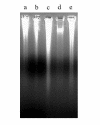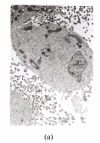Cytotoxicity of epigallocatechin-3-gallate to LNCaP cells in the presence of Cu2+
- PMID: 15633248
- PMCID: PMC1389627
- DOI: 10.1631/jzus.2005.B0125
Cytotoxicity of epigallocatechin-3-gallate to LNCaP cells in the presence of Cu2+
Abstract
Epigallocatechin-3-gallate (EGCG) has shown remarkably anti-cancer activity, with its bioactivity being related to reactive conditions, such as pH and metal ions. The present study investigated the degradation of EGCG and its effect on prostate cancer cell in the presence of Cu2+. EGCG was incubated with prostate cancer cells, LNCaP, pretreated with or without Cu2+. EGCG in F-12 medium was quantified using HPLC and the viability of cells was assessed by gel electrophoresis, flow cytometry, and electron microscope. The results of HPLC showed that EGCG degraded completely within 12 h in F-12 medium with or without Cu2+. Gel electrophoresis and flow cytometry did not detect apoptosis of LNCaP cells when they were incubated with EGCG. Electron microscopy examination revealed that EGCG-Cu2+ complex led to damage of cytoplasm membrane in LNCaP cells. It was speculated that not EGCG, but its oxide and complex with Cu2+, are the bioactive components responsible for its cytotoxicity to LNCaP prostate cancer cells.
Figures













Similar articles
-
Investigations of the cytotoxicity of epigallocatechin-3-gallate against PC-3 cells in the presence of Cd2+ in vitro.Toxicol In Vitro. 2008 Jun;22(4):953-60. doi: 10.1016/j.tiv.2008.02.005. Epub 2008 Feb 15. Toxicol In Vitro. 2008. PMID: 18359184
-
Green tea polyphenols and its constituent epigallocatechin gallate inhibits proliferation of human breast cancer cells in vitro and in vivo.Cancer Lett. 2007 Jan 8;245(1-2):232-41. doi: 10.1016/j.canlet.2006.01.027. Epub 2006 Mar 6. Cancer Lett. 2007. PMID: 16519995
-
Growth inhibition of prostate cancer cells by epigallocatechin gallate in the presence of Cu2+.J Agric Food Chem. 2004 Feb 11;52(3):462-6. doi: 10.1021/jf035057u. J Agric Food Chem. 2004. PMID: 14759133
-
Role of epigallocatechin gallate (EGCG) in the treatment of breast and prostate cancer.Life Sci. 2006 Nov 17;79(25):2329-36. doi: 10.1016/j.lfs.2006.07.036. Epub 2006 Aug 5. Life Sci. 2006. PMID: 16945390 Review.
-
Nanochemoprevention: sustained release of bioactive food components for cancer prevention.Nutr Cancer. 2010;62(7):883-90. doi: 10.1080/01635581.2010.509537. Nutr Cancer. 2010. PMID: 20924964 Free PMC article. Review.
Cited by
-
Therapeutic Potential of Polyphenols from Epilobium Angustifolium (Fireweed).Phytother Res. 2016 Aug;30(8):1287-97. doi: 10.1002/ptr.5648. Epub 2016 May 24. Phytother Res. 2016. PMID: 27215200 Free PMC article. Review.
-
Essential Elements and Isoflavonoids in the Prevention of Prostate Cancer.Nutrients. 2022 Mar 14;14(6):1225. doi: 10.3390/nu14061225. Nutrients. 2022. PMID: 35334882 Free PMC article.
-
Epigallocatechin-3-gallate and zinc provide anti-apoptotic protection against hypoxia/reoxygenation injury in H9c2 rat cardiac myoblast cells.Mol Med Rep. 2015 Aug;12(2):1850-6. doi: 10.3892/mmr.2015.3603. Epub 2015 Apr 8. Mol Med Rep. 2015. PMID: 25872640 Free PMC article.
-
Epigallocatechin-3-gallate affects the growth of LNCaP cells via membrane fluidity and distribution of cellular zinc.J Zhejiang Univ Sci B. 2009 Jun;10(6):411-21. doi: 10.1631/jzus.B0820400. J Zhejiang Univ Sci B. 2009. PMID: 19489106 Free PMC article.
References
-
- Chung LY, Cheung TC, Kong SK, Fung KP, Choy YM, Chan ZY, Kwok TT. Induction of apoptosis by green tea catechins in human prostate cancer DU145 cells. Life Sciences. 2001;68(10):1207–1214. - PubMed
-
- Chung JY, Park JO, Phyu H, Dong ZG, Yang CS. Mechanisms of inhibition of the Ras-MAP kinase signaling pathway in 30.7b Ras 12 cells by tea polyphenols (-)-epigallocatechin-3-gallate and theaflavin-3,3′-digallate. The FASEB Journal. 2001;15:2022–2024. - PubMed
-
- Cutter H, Wu LY, Kim CD, Morre J, Morre DM. Is the cancer protective effect correlated with growth inhibitions by green tea (-)-epigallocatechin gallate mediated through an antioxidant mechanism? Cancer Lett. 2001;162(2):149–154. - PubMed
-
- Gupta S, Ahmad N, Nieminent AL, Mukhtar H. Growth inhibition, cell-cycle dysregulation, and induction of apoptosis by green tea constituent (-)-epigallocatechin-3-gallate in androgen-sensitive and androgen-insensitive human prostate carcinoma cells. Toxicology and Applied Pharmacology. 2000;164(1):82–90. - PubMed
-
- Gupta S, Hussain T, Mukhtar H. Molecular pathway for (-)-epigallocatechin-3-gallate-induced cell cycle arrest and apoptosis of human prostate carcinoma cells. Archives of Biochemistry and Biophysics. 2003;410(1):177–185. - PubMed
Publication types
MeSH terms
Substances
LinkOut - more resources
Full Text Sources
Medical
Miscellaneous

